|
|
|
|
 |
==Bhaja
(c.100).
These early Buddhist rock-cut temples at Pune are somber and simple, centered
on halls with stupas, but also adorned with guardian sculptures and graceful
bas-reliefs. Images: *AIIS
Penn*; *DSAL*;
*Berger*.
[*Routes*] |
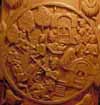 |
==Bharhut
(c.100-80 BCE): a Buddhist site in Madhya Pradesh famous for its vividly
decorated railing with a smooth flow of narrative scenes from the Buddha's
life. Its good pieces are now in museums. Images: *DSAL*;
*IGNCA*. |
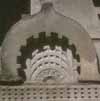 |
==Ajanta
deserves special attention for its remarkable size and complexity: over
the centuries; especially from c.400 CE onward, it acquires many Hindu
caves in addition to its early Buddhist and Jain ones. Images: *DSAL*;
*Berger*;
discussion: *art
and archaeology*; IGNCA: *one*,
*two*,
*three*,
*four*,
*five*.
[*Routes*] |
 |
==Augustus
Caesar reflects on his Indian connection (c.26-20 BCE): listing
his achievements at the end of his life (*MIT*),
he comes to achievement #31: "Emissaries from the Indian kings were often
sent to me, which had not been seen before that time by any Roman leader." |
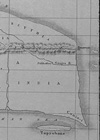 |
==Strabo
too speaks of Indian emissaries to Caesar: In section 4 of
his "Geography" (*Internet
Sourcebook*) he provides a few tantalizing details: "But from India,
from one place and from one king, I mean Pandion, or another Porus, there
came to Caesar Augustus presents and gifts of honour and the Indian sophist
who burnt himself up at Athens, as Calanus had done, who made a similar
spectacular display of himself before Alexander." (For more on Calanus,
see Strabo's section 68.) "King Pandiod" is thought to have been a Pandya
king from the tip of the South Indian peninsula. Strabo is also a major
source for *Munster's
Cosmographia*. |
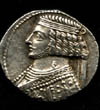 |
==the
Parthians (c.10 BCE - 0): For a brief period, the Pahlavas
or Parthians (*parthia.com*)
are able to extend their Persian and Central Asian domain eastward to include
northern Pakistan. King Phrates IV (r.38-2 BCE) is active in this effort.
The trade route through the Parthian empire to India is so important that
the Parthians maintain way stations all along it for travelers. Isidore
of Charax describes this route in "Parthian
Stations," his manual for merchants. |
 |
==the
Indo-Scythian Shakas: About this time (c.20 BCE - 80 CE),
a group of Central Asian Scythians, called "Shakas" in India, drive out
the last of the Indo-Greek kings. The first of their line is a king called
Maues, who rules in Gandhara. Little is known about him except through
the evidence of his Greek-and-Kharoshti coins. [*Routes*] |
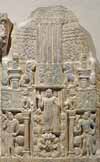 |
==Mahayana
Buddhism develops (00's BCE - 00's CE), and becomes the dominant
Buddhist school in South Asia and also abroad: *Sources
of Indian Tradition*. In contrast to the earlier Theravada school with
its simplicity and emphasis on personal striving, in Mahayana Buddhism
the cosmology becomes very elaborate, with many Buddha-heavens and Bodhisattvas
and other beings now involved in the working out of humans' destinies. |
|
|









